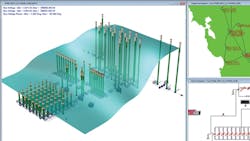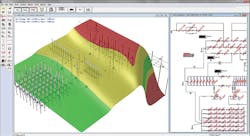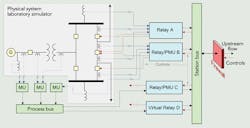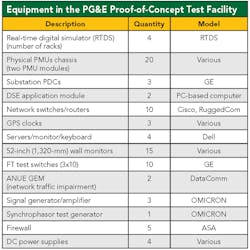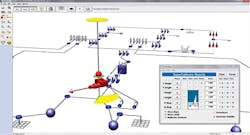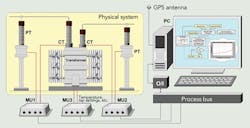PG&E Improves Information Visibility
To date, phasor measurement units (PMUs) have been applied most often on the transmission grid. But, as more PMU applications on distribution stations and networks are identified, and as the business case to support distribution-level applications improves, the expectation is a vast change in the number of deployments at distribution levels. Because PMUs sample network conditions 60 times/sec to 120 times/sec, this is likely to be yet another “big data” event with the concomitant taxing of central processing capabilities and further complexity in control center algorithms that sift through data for actionable knowledge.
The long-sought, real-time view of the system as a whole will, of course, pay dividends in helping operators to anticipate and address state and stability issues on the distribution system. Pacific Gas and Electric Co. (PG&E) and the Georgia Institute of Technology recently collaborated to develop and deploy software applications that reside on the platform provided by distributed, embedded intelligence in the substation. The software has been validated at a proof-of-concept facility, engineered to mimic typical field environment, and later in the field. There are several tangible benefits that real-time situational awareness provides in enabling utilities to more effectively manage and integrate the data generated by the intelligent electronic devices (IEDs) in the substation.
PMUs can enable real-time visibility into a substation and downstream assets. However, a platform and method are needed to gather and analyze the synchronized data streaming from PMUs and information provided by other IEDs, including protective relays and fault data recorders that track current, voltage and phase angles.
DSE Technology and Methodology
Software applications that rely on distributed intelligence embedded at the substation level have been developed and implemented. The applications provide the platform for distributed state estimation (DSE). Only pertinent, validated values, a fraction of the available data, are sent upstream to the control center to minimize congestion on communications networks and to inform a centralized state estimation model that formerly relied mostly on calculated values for substations.
The work has led to the development of three applications that ride on the embedded platform: real-time visibility into substation health, voltage-stability monitoring and setting-less protection.
These are the first of many applications that may be developed as a result of this approach. Ultimately, DSE and related applications should increase operational reliability, improve asset management, aid resource planning and provide more accurate data for centralized state estimation models and enterprise applications. The value of these innovations also makes the business case for substation automation more robust.\
How DSE Works
In the DSE system architecture, a substation’s PMUs and other IEDs send their measurements and status data to a phasor data concentrator (PDC). The PDC is equipped with networked application hardware. The application module contains the DSE software and processes PMU and other IED data using the network between the application module and PDC. The internal network between the PDC and application card can support IEEE C37.118.2 transport or via IEC 61850 from the security provided by IEC 61850. The PDC aligns the values of disparate streams of data, based on their GPS-based time stamps. The aligned, synchronized data is sent to the DSE application, which processes and validates the data.
Once the DSE constructs a model from the available and validated data configured from local computation, the model can send a fraction of the most pertinent values to the control center, informing and improving the central state estimation model. The configuration setup also includes user-selectable steps to manage the bandwidth between substations and the control center by selecting the quantity and type of data transmitted to the centralized state estimator. The DSE also quantifies the accuracy of the data. Because monitoring may not cover every element in the substation, the DSE model uses actual measurements of the monitored data to calculate values for the unmonitored equipment where applicable.
When data sent upstream is comprised of computed values, it is flagged to indicate the accuracy level for use by enterprise applications or for visualization purposes. If the data fits the associated device model from which it was obtained, that’s one test of DSE model validity. Data that does not fit the corresponding model (that is, it is not consistent with the physical laws governing the device) is characterized as bad data, and the process triggers an automated response and alerts operators through visual dashboards to isolate the problem. For instance, PMUs can go out of calibration and produce bad data. The DSE model will detect that and alert operators.
Process Data in the Field
One major advantage of DSE versus centralized state estimation derives from distributed intelligence: placing processing power closer to the monitored equipment. By processing the bulk of the data locally (at the substation level) and sending only a fraction of the most pertinent results upstream, central state estimation can be updated 60-plus times/sec. This is a vast improvement from current approaches that refresh central state estimation every minute or so. The result is a more timely and accurate central state estimation model, as well as real-time visibility into substation and distribution network health.
With DSE models, all three phases at the substation are monitored rather than just a single phase, as in the past. In fact, granular evidence shows that power system behaviors, which previously could only be hypothesized, now can be observed with this method.
Validating Data Creates Value
The processing, validation and extraction of pertinent data from the massive data streams generated in the field has implications beyond just winnowing the wheat from the chaff. Sending torrents of data from PMUs and other IEDs upstream to a control center over communications networks with limited bandwidth can congest those networks and corrupt data riding on them. For instance, PMUs can output six streams of data taking 60 measurements/sec, 120 measurements/sec or an even higher number of measurements/sec. Add data streams from other IEDs that track power quality and data transport, and storage may become impractical.
The distance between IEDs in the field and centralized processing can lead to inaccurate or compromised data, based on line impedance alone. Processing torrents of data at the control center can burden servers and detract from other processing priorities.
Applications Beyond DSE
DSE is just one of many applications enabled by the local measurements and computations. The accuracy obtained from performing local measurements via the DSE model provide more precise oscillation information than the centralized systems. The DSE model can be used to run contingency analyses in real time to test various remedial strategies. Thus, the approach described fills a gap in monitoring technology between high-speed protection systems and slower-speed supervisory control and data acquisition (SCADA) systems.
Another application is voltage-stability monitoring, which relies on the ability of the DSE model to create subnetworks. Because voltage management often tends to be local in nature, but power systems tend to sprawl, locating and understanding voltage stability issues often presents a challenge. The creation of subnetworks allows a power system area to be divided into manageable units, making the search for the source of voltage volatility speedier and more accurate. Thus, the DSE model can guide corrective actions such as the application of reactive power and improve resource planning for problematic sections of the power system.
A side benefit of the localized measurements is the capability to generate accurate protection set points. Because a DSE provides details on the health of each device in a substation, an unhealthy condition such as an internal fault is readily detected and initiates a tripping signal. Operators are alerted to take remedial steps. Data on the health of a single device does not need to be coordinated with other protection schemes.
The DSE provides a picture of the health of all devices within a protection zone; therefore, no coordination of devices with protection schemes is needed within each zone. Still, traditional protection schemes may remain in place as a backup.
Meanwhile, Upstream
A major benefit of DSE — with its validated, synchronized data insights — is the centralized state estimation model being informed by this accurate, perfectly aligned data. A centralized model does not need to crunch substation data. The accuracy of substation data benefits not only operations, which rely on the central state estimation model, but also the enterprise applications that run on the centralized model.
Responses to the inaccuracies detected by the DSE model can be automated or delivered to operators through visualization in dashboards, which provide both numeric values and color-coded indices to alert operators to emerging issues. This hybrid approach is typical today and automated responses can be programmed at the substation level.
Localized processing improves data quality as the measurements and the model are closer to the data source. Furthermore, quality information can be communicated quickly to the control center for faster situational awareness to alert operators or take automated actions where speed beyond human processing capability is necessary.
Scalability Versatility
The technology described is distributed and embedded at the substation. It is applied at each substation independently, which speeds the process as substation-level results are transmitted to the control center. Because computations are performed by embedded intelligence at each substation, the approach and applications are scalable to any size system. Further investment may be required to increase the bandwidth in communications networks between each substation and the control center. Sound engineering practices must be applied to identify sufficient processing power for the central controller servers, based on the number of substations intended for deployment and, as a result, the scale of anticipated data streams.
Implementations Underway
Field demonstrations of DSE concept have taken place over the past two years at PG&E and several other utilities.
PG&E has implemented the approach on a limited basis by initially validating it at the utility’s proof-of-concept test facility in Northern California and then at two switchyards within its transmission system. The POC facility was developed with cofounding support of the U.S. Department of Energy as part of the PG&E Smart Grid Investment Grant for synchrophasor system deployment.
PG&E now has the option to expand the use of DSE, once it completes its life-cycle analyses of the technology and its business case. The utility is laying the groundwork by investing several million dollars in a nearly decade-long substation automation project. Once a substation is equipped with PMUs and other monitoring devices to provide real-time information, and a PDC and processing power are installed to store and analyze data, it is an inexpensive step to add the DSE software platform and applications.
Specialized Training
As noted, substation automation must be in place to apply the technologies described here. While the technology implementation requires modeling and configuration setup, using DSE will require new skills.
The implementation of DSE using the approach described here represents a paradigm shift for the utility workforce, as it applies measurements down to 100 nsec of absolute time accuracy. In the past, 1-msec accuracy was the benchmark. Higher sampling rates have a ripple effect across the organization, affecting the communications group, among others.
Deploying a DSE based on PMU capabilities is a specialized skill that, over time, will require new curricula in universities and on-the-job training at a utility.
Commercialization on the Rise
The American Recovery and Reinvestment Act included US$3.4 billion for power utility grants that boosted the market for PMUs, among other technologies, resulting in price drops for the devices. The cost of GPS clocks, in particular, has dropped. More importantly, as prices have dropped, PMU functionality has increased five-fold.
The PMU Promise
DSE provides insights into voltage, current, power quality, phase angle, and real and reactive power flows for every device, system and node at the substation level and downstream, based on actual measurements. These granular, hyper-frequent measurements enable incipient failure prediction, run contingency analyses in fractions of a second and generate automated responses where needed.
DSE finally harnesses the long-held promise of PMUs providing greater reliability for operations and improving outcomes for asset management and other centralized enterprise applications. Once a DSE is created, the field is open for new applications and data mining. With the approach described here, the sky is the limit.
Acknowledgement
The authors wish to acknowledge the support and active involvement of John McDonald, director, technical strategy and policy development, GE Digital Energy.
Vahid Madani ([email protected]) is a technology leader for advanced power systems applications at Pacific Gas & Electric, currently focused on grid modernization and deployment of emerging technology, including synchrophasor systems and geomagnetic disturbance resiliency. Dr. Madani is the immediate past chair of Reliability and Remedial Action Schemes Committee at Western Electricity Coordinating Council and chair of the Performance Standards for Synchrophasor at NASPI. He received the 2013 IEEE Prize Paper Award on wide-area system integrity protection schemes and recognition from the U.S. Department of Energy for his leadership and technical contributions supporting the Smart Grid Synchrophasor Standards development.
A.P. Sakis Meliopoulos ([email protected]) is the Georgia Power Distinguished Professor, Georgia Institute of Technology. His research on synchronized measurements and applications spans more than 25 years. He developed the first wide-area monitoring system for the New York Power Authority using the Macrodyne 1690 PMU, distributed state estimator and synchronized measurement-based setting-less protection.
Companies mentioned:
Georgia Institute of Technology | www.gatech.edu
IEC | www.iec.ch
IEEE | www.ieee.org
New York Power Authority | www.nypa.gov
Pacific Gas and Electric Co. | www.pge.com
